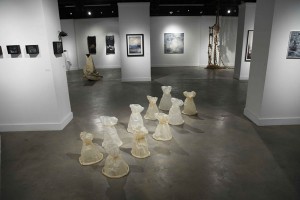« Reviews
Collective Consciousness
Bakehouse Art Complex - Wynwood Art District, Miami
March 13 - April 2, 2009
By Denise Colson
The Bakehouse Art Complex recently exhibited “Collective Consciousness,” curated by Lauren Wagner, which included works by Patricia Schnall Gutiérrez, José Pacheco Silva, Tina Salvesen, Jennifer Basile and Ingrid Eliasson. According to its catalogue, the show was based on the term “collective consciousness” coined by Emile Durkheim at the end of the nineteenth century. The French sociologist used the term to refer to the sharing of beliefs, feelings and attitudes, which act and operate as a unifying force within society. According to this theory, a society, a nation or a group constitutes an entity that behaves, as far as conscience is concerned, like a global individual.
The concept on which the exhibition was based visualized the Bakehouse as a space that symbolically functions like the boundaries that determine the limits of a society, conditioning a common way of thinking and acting among the artists who congregate there. This assertion, in my humble opinion, is somewhat forced. Although inevitably philosophical and aesthetic exchanges and coincidences, which might establish certain conceptual and formal connections among their works, may occur among creators who have studios on the premises; to presuppose the existence of a “collective consciousness” is an assertion guided by good intentions, but perhaps not very objective. The conscience, as an individual’s faculty to know himself, includes beliefs and feelings that have close ties to the nuclear family into which he is born, the social context in which he grows up and his religious affiliation, among many other factors. Thus, it would be an absolute sin to presuppose the existence of a collective consciousness in a group of artists who only spend part of their time at the Bakehouse; an undoubtedly beneficial exchange but neither sufficient nor decisive enough to engender a collective consciousness. However, if we consider Durkheim’s term in an allegoric sense, it could then function to detect links between the works included in this exhibition.
The assembled works offer a wide spectrum of expressive media and artistic trends. Nevertheless, they manage to blend conceptually through a curatorship, which is structured based on the analysis of implicit narratives in each of the pieces, narratives that explore the experiential as the backbone of each piece and as the directional axis of the exhibition. It is precisely from experience that other concepts then emerge associated with vital processes such as: evolution, growth, change, adaptation, and death, as well as ideas cherished by human beings such as desire, recollection and nostalgia.
Tied to recollection are the many pieces by Patricia Schnall Gutiérrez. These works are based on a series of autobiographical portraits that the artist produced over the past ten years. They served as an incentive to explore her childhood memories, her childhood experiences in a context in which religion permeated that fine line between life and death. These personal quests gave rise to an abundant collection of paintings and installations of a profoundly intimist nature.
For its part, Tina Salvesen’s Knot Project invited the visitor to participate in the installation. Knot Project invokes life as a cord along which one finds many knots. Each knot represents an experience, which helps us grow, learn and mature: a divorce, a loss, a birth, a union. The spectator is invited to leave, at the installation, those knots that symbolize imprints of significant events in his life. The way in which we confront these experiences, share them and are able to “undo” the knots draws us closer to each other as human beings.
Filed Under: Reviews



































